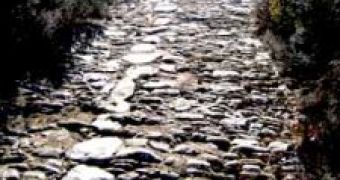You do not have to travel to sunny Italy to step on a "Via Romana".
Dutch archaeologists have discovered a part of the military Roman road, used nearly 2,000 years ago by soldiers guarding against hostile Germanic tribes at the Roman Empire's northern boundary.
"Known in Latin as the "limes," the road was in use from roughly A.D. 50 to A.D. 350, before it fell into disrepair and eventually disappeared underground," said archaeologist Wilfried Hessing, who is leading the excavations in Houten, about 30 miles (50 km) southeast of Amsterdam.
This stretch of road is supposed to have linked two forts: Traiectum (modern Utrecht), and Fectio (now Vechten).
"Wooden poles were discovered at the site that were used to protect the roadsides from erosion, and experts hoped to use tree-ring counting techniques to determine the exact date they were cut," Hessing said.
"It was used for trade, but it was first and foremost part of a military strategy to guard the border," he said. With a road "you can respond more quickly, so you need fewer troops, just like today."
The discovery was made by the Dutch train company Prorail during constructing works in the area.
"Hessing and Prorail will complete excavations of a short stretch in the coming weeks, then carry out exploratory digs to determine the road's route farther to the east".
"It's in very good condition," said Houton's spokeswoman Marloes van Kessel.
This roman road is also investigated in neighboring countries, and the United Nations is considering declaring it a world heritage site.
Hessing said the road was built of a sloping mound of sand and clay, interspersed with layers of gravel and smashed seashells, which would have stood about a yard above nearby fields.
Unusual is the preservation level of the top layer of hard-packed gravel.
"Pottery shards were used as filler material and will help experts in dating the road", Hessing said.
The "via" was also sided by drainage channels, and the wooden poles were used to shore up the foundation.
Examinations of a cross-section of the road revealed it had been repaired several times.
"It will be interesting to see if we can tell whether those repairs correspond with known military campaigns or were just part of standard maintenance," he said.
Romans occupied the territory of the current Netherlands under Julius Caesar in the year 53 B.C., when the zone was part of Gaul.
An uprising began in A.D. 69 when the local Germanic Batavian tribe captured two coastal forts, but it was defeated.
The limes' course is known from medieval copies of Roman maps, but only several segments have been found intact in the Netherlands.
In the last years, many others Roman remains were find in Netherlands: in 2002, the remains of a watchtower on the Rhine were found, where detachments of three or four Roman soldiers would have served as lookouts.
In 2003, a 25-yard-long barge was found, which may have been used by a paymaster to sail upriver carrying supplies to military camps and bases.
Items associated with the barge were a knife, saw, wooden shovel, shears, copper pot, clay cups and pots, paddle with traces of blue paint, iron crowbar, leather shoe soles with studded bottoms for extra strength, and a piece of wood with Roman numbers on it.

 14 DAY TRIAL //
14 DAY TRIAL //